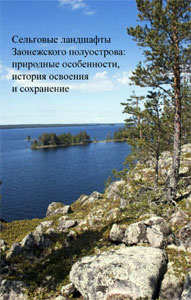Publications
Scientific publications

Сельговые ландшафты Заонежского полуострова: природные особенности, история освоения и сохранение
Ред. А.Н. Громцев.
Петрозаводск: КарНЦ РАН, 2013. 180 с.
Selka landscapes of the Zaonezhskii peninsula: natural сharacteristics, land use, conservation. / Ed. A.N. Gromtsev. Petrozavodsk: KarRC RAS, 2013. 180 p.
The book provides a comprehensive description and assessment of the natural complexes of the Zaonezhskii Peninsula selka ridge landscapes. The results of surveys by five institutes of the Karelian Research Centre coupled with the analysis of an extensive pool of published data are presented. They are structured into several major sections.
First come the brief summary and assessment of the general physiographical features of the territory (climate, geological-geomorphological, hydrological and soil conditions). Then terrestrial ecosystems (geographical terrains, mires, mire forests, forests, meadows) are described and assessed. The next section is devoted to plants (vascular plants, mosses, fungi, lichens) and animals (mammals, birds, insects), including checklists of red-listed species. Data are reported also on the aquatic flora and fauna (aquatic plants, zoobenthos, fish). Special consideration is given to archaeological materials, analysis of the historical and ethnographical features of the area and its land use history, including the modernity. General conclusions at the end of the book are combined with the substantiation of the expediency of making this territory a protected area.
The book is supplied with 59 figures, 22 tables and 8 annexes. It can be reached online at the Karelian Research Centre website in the «Year 2013 publications» section.
First come the brief summary and assessment of the general physiographical features of the territory (climate, geological-geomorphological, hydrological and soil conditions). Then terrestrial ecosystems (geographical terrains, mires, mire forests, forests, meadows) are described and assessed. The next section is devoted to plants (vascular plants, mosses, fungi, lichens) and animals (mammals, birds, insects), including checklists of red-listed species. Data are reported also on the aquatic flora and fauna (aquatic plants, zoobenthos, fish). Special consideration is given to archaeological materials, analysis of the historical and ethnographical features of the area and its land use history, including the modernity. General conclusions at the end of the book are combined with the substantiation of the expediency of making this territory a protected area.
The book is supplied with 59 figures, 22 tables and 8 annexes. It can be reached online at the Karelian Research Centre website in the «Year 2013 publications» section.
Indexed at RSCI
![]() selka_landscape.pdf (29.48 Mb, total downloads: 379)
selka_landscape.pdf (29.48 Mb, total downloads: 379)
Contents:
| Introduction (A. Gromtsev) | 7 |
| 1. Location of the Zaonezhskii peninsula in system of the nature zoning and physical –geographical features (A. Gromtsev, V. Karpin) | 11 |
| 2. Description and assessment of the general physiographical characteristics of the territory | 17 |
| 2.1 Geological conditions and bedrock species (А. Golubev, A. Polin, D. Rychanchik, А. Romashkin) | 17 |
| 2.2 Geological-geomorphological characteristics and Quaternary deposits (T. Shelekhova) | 29 |
| 2.3 Hydrological network (A. Litvinenko, M. Bogdanova) | 36 |
| 2.4 Soil cover (O. Bakhmet, N. Fedorets) | 47 |
| 3. Description, assessment and recommendations on the conservation of terrestrial ecosystems | 51 |
| 3.1 Ecosystems at the geographical terrain level (A. Gromtsev, V. Karpin) | 51 |
| 3.2 Mires (О. Kuznetsov, V. Antipin, P. Tokarev) | 54 |
| 3.3 Mire forest (S. Kutenkov) | 61 |
| 3.4 Forest cover (A. Gromtsev, V. Karpin, N. Petrov, Y. Presnukhin, A. Tuyunen) | 65 |
| 3.5 Meadows (S. Znamenskiy) | 75 |
| 4. Description, assessment and recommendations on the conservation of terrestrial flora and fauna | 82 |
| 4.1 Vascular plants (A. Kravchenko, V. Timofeeva) | 82 |
| 4.2 Karelian birch (L. Vetchinnikova) | 93 |
| 4.3 Mosses (A. Maksimov) | 98 |
| 4.4 Fungi | 102 |
| 4.4.1 Wood-decay fungi (A. Ruokolainen) | 102 |
| 4.4.2. Mushrooms, Pufballs and Sac Fungi (O. Predtechenskaya) | 109 |
| 4.5 Lichens (M. Fadeeva) | 114 |
| 4.6 Mammals (V. Belkin, P. Danilov, D. Panchenko) | 121 |
| 4.7 Birds (S. Sazonov) | 126 |
| 4.8 Insects (A. Polevoi, A. Humala) | 134 |
| 5. Description, assessment and recommendations on the conservation of aquatic flora and fauna | 139 |
| 5.1 Hydrobiological features of waterbodies and watercourses (S. Komulainen, А.Kruglova, I. Barushev, А. Ryabinkin, Т. Kulikova, Т. Chekryzheva) | 139 |
| 5.2 Fishes (О. Sterligova) | 147 |
| 6. Land use history and traditions | 150 |
| 6.1 Archaeological monuments (N. Lobanova) | 150 |
| 6.2 Historical-ethnographic characteristics of the region (K. Loginov) | 151 |
| 6.3 Specific features and traditions of nature use (S. Potakhin) | 156 |
| 7. General conclusions and recommendations (A. Gromtsev, V.Karpin) | 159 |
| Regulations of the landscape reserve (draft) | 165 |
Last modified: April 19, 2016


